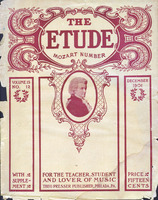So much is constantly being said and written about what is termed the Joachim Bowing, that the present writer feels constrained, from time to time, to add something to what he has already written on this widely misunderstood question. The student-world is not in need of fantastic theories, nor is it benefited by the zealously-promulgated opinions of men who are content to accept any situation as they find it, regardless of the absurdities or inconsistencies which it presents to the thoughtful individual. But what the student-world does require is facts. The difficulties of the art of violin-playing are not lessened by fanatic devotion to a great artist, nor is it possible to convert a hap-hazard theory into a truth by any means which personal respect or adulation may devise. The student-world, it must be repeated, is in need of facts; and nothing is more harmful to the serious and aspiring young violinist than to have forced upon him theories born in a fanciful, but illogical, brain, and colored so as to resemble truth.
Before proceeding, however, I wish to say that it seems necessary, in the present case, to avoid generalizations and everything which may be erroneously construed as personal opinion. Here, also, plain, unvarnished facts will find readier acceptance, and will more readily contribute to a clear understanding of this vexed question than any statements which may resemble individual opinion.
When, in the year 1889, I traveled to Berlin for the purpose of closely studying Joachim’s art and all that made him a unique figure in the violin-world, I followed the example set by countless well-equipped players who, on the verge of instrumental maturity, had felt the need of a guide and model so great and classic as Joseph Joachim. Comparatively little had been said or written, at that time, regarding Joachim’s methods as an instructor or his real pedagogical abilities. It was all conjecture with most violinists, who had simply worshiped Joachim from afar; but the supposition that the venerable artist knew, and divulged to his pupils, secrets unknown to other pedagogues was hardly more than natural. I do not hesitate to say that I had been one of the most ardent of Joachim’s worshipers, and that I had dreamed all sorts of dreams regarding that mysterious world of art whose gates should swing open to me when I stood on the threshold of the Hochschule.
It will thus be understood that I entered upon my new studies with veneration for Joachim, with an intense craving to learn some of the secrets of his art, with no hastily-formed views prejudicial to the methods employed at the Hochschule, but with an eager, though humble, spirit; and a strong determination to follow, and profit by, Joseph Joachim’s teachings.
As the result of a whole year’s study, observation, and experience, I learned many new and astonishing things. Confining myself to the more important revelations of that year, the knowledge which I acquired may be summed up briefly, as follows:
1. I learned that a so-called system of bowing had been devised at the Hochschule, known as the “Joachim Bowing,” whose ostensible purpose was to enable players to acquire the peculiar and wonderful mastery of the bow which has always distinguished Joachim’s art.
2. I learned, with amazement, that, of the many gifted players who, at that time, were earnestly and persistently endeavoring to acquire the so-called
Joachim Bowing, not one had succeeded in proving anything more than the hopelessness of the “system” in vogue at the Hochschule.
3. I learned that, as a result of the methods employed to acquire this peculiar bowing, many students were suffering from physical ailments which threatened permanently to disable their right arms so far as violin-playing was concerned.
4. I learned that Joachim taught his pupils nothing relating to the so-called “Joachim Bowing.”
5. I learned, alas, that Joachim rarely made any effort to impart knowledge, and that the student’s progress and achievements depended chiefly upon his natural gifts, his powers of observation, and his assiduity.
6. I learned that the majority of Joachim’s assistants were remarkably incapable violinists.
7. And I learned that violin-tone at the Hochschule was chiefly characterized by crudities which would never be tolerated in Belgium, in France, or—in the United States.
Amazed at what I saw and heard, but not yet fully convinced of the justice of my own views and the correctness of my conclusions, I made every possible effort to obtain from well-known artists their authoritative opinions on the various phases of this question. The information thus obtained more than strengthened the views I held; and the pedagogical “triumphs” of the Hochschule during the past twelve years have certainly not tempted me to recede from the position I took in 1889, nor have they been of a character to modify my old-time irreverence of Hochschule methods.
On this strange, yet interesting, subject there yet remains to be said something of peculiar significance.
Some years ago, and again quite recently, I freely discussed this question of “Joachim Bowing” with reputable artists who had studied with Joachim when the Hochschule was in its infancy. These men, without exception, made the positive statement that, in those days, there was absolutely nothing known concerning any system of bowing based on Joachim’s right-arm achievements. They, too, have learned the origin of that dismal failure known as the “Joachim Bowing.”
These are facts.



